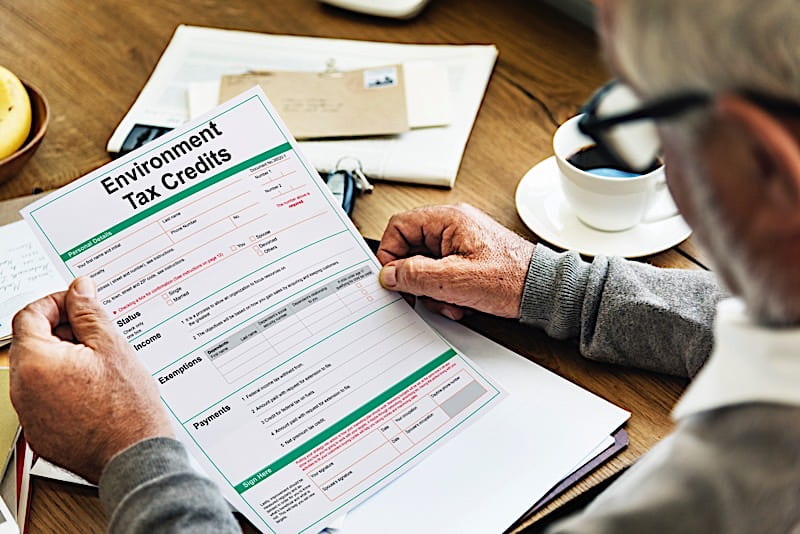Tax season represents one of the most divisive times of the year; it’s either dreaded for fear of owing money to the federal government or anticipated with excitement. Meanwhile, there is an entire industry with a propensity towards the latter: real estate investors. Entrepreneurs dealing primarily in real estate are in a unique position to reduce their exposure to costly taxes and maximize returns. That is, of course, if they know about each and every deduction they are entitled to make.
Not all deductions are as obvious as we would like to assume; there are some that are easier to miss than others. The energy tax credit, for example, is underutilized but instrumental for those who want to maximize their tax returns. Investors who want to make the most out of their upcoming tax season need to not only be aware of the energy tax credits made available but also how to capitalize on them.
[ Thinking about investing in real estate? Register to attend a FREE online real estate class and learn how to get started investing in real estate. ]

Types Of Energy Tax Credits
The government has made the need for clean, renewable energy more apparent than ever before, as evidenced by the numerous energy tax credits made available to homeowners and real estate investors. Consequently, a number of energy tax credits have been introduced to incentivize the addition of environmentally conscious upgrades. It is now easier than ever to simultaneously reduce your carbon footprint while maximizing your tax return.
Whether you are a landlord or traditional homeowner, these credits may be able to help you maximize your tax return and improve the efficiency of your property:
-
Residential Renewable Tax Credit
-
Non-Business Energy Property Tax Credit
-
Solar Energy Tax Credits
According to IRS.gov, “the residential energy efficient property credit allows for a credit equal to the applicable percent of the cost of qualified property. Qualifying properties are solar electric property, solar water heaters, geothermal heat pumps, small wind turbines, fuel cell property, and, starting December 31, 2020, qualified biomass fuel property expenditures paid or incurred in taxable years beginning after that date.”
That said, it is advised you make sure any tax credits are still being offered before you make any attempt to claim them, as rules and regulations are always changing.
Non-Business Energy Property Tax Credit
The residential renewable tax credit is designed to promote more efficient heating and cooling systems in today’s homes. More specifically, however, homeowners may be credited 10% of the cost for making any of the following improvements (including installation and labor costs):
-
Electric heat pump water heaters
-
Electric heat pumps
-
Natural gas, propane, or oil water heaters
-
Central air conditioners
-
Natural gas, propane, or oil water boilers
-
Natural gas, propane, or oil furnaces
-
Advanced main air-circulating fan used in a natural gas, propane, or oil furnace
-
Biomass fuel stoves
Qualifying taxpayers may claim up to $500 on Form 5695. In order to make the claim, however, homeowners will need to do a lot more than say they made the necessary changes; they will need certification statements from the manufacturer suggesting the appliance meets the criteria set forth by the credit.
Residential Renewable Tax Credit
In 2018 to 2021, a person may claim a credit for 10% of the cost of eligible energy efficiency improvements and the amount of residential energy property expenditures paid or incurred by the taxpayer during the taxable year up to a maximum credit of $500.
Qualified energy efficiency improvements include:
-
Doors
-
Exterior windows
-
Metal & asphalt roofs
-
Roof products
-
Insulation
-
Heating & cooling systems
-
Biomass burners (natural gas, propane, or oil)
-
Water heaters
Solar Energy Tax Credits
In an effort to promote the use of solar power, both the Environmental Protection Agency (EPA) and the Department of Energy are offering significant tax credits to those who add solar systems to their primary residences. The owners of rental properties, however, can only claim this tax credit if they live in the rental for part of the year and place it in service for the rest of the year. In doing so, the credit will be reduced to reflect the limited residency. Rental property owners who live in the home for three months out of the year, for example, may only be entitled to 25% of the credit.
The federal residential solar energy credit is a refundable tax credit equal to a percentage of the cost of a solar photovoltaic (PV) system that may be claimed on federal income taxes. The system must be fully installed and operational during the tax year and provide power to a residence in the United States.
Congress extended the Investment Tax Credit (ITC) in December 2020, providing a 26% tax credit for systems installed between 2020 and 2022 and a 22% tax credit for systems installed in 2023. (Systems installed between January 1, 2019 and December 31, 2019 qualified for a 30% tax credit.) Unless Congress extends the tax credit, it will expire in 2024.

Energy Tax Credits For Rental Property Owners
Most energy tax credits are only issued to the owners of primary residences. More specifically, none of the residential energy tax credits are available to owners of rental properties, with a few exceptions:
-
Geothermal Heat Pumps
-
Solar Panels
-
Solar Water Heaters
-
Small Wind Energy Systems
Each of these energy tax credits is intended for homeowners’ primary residences, but they may be extended to those who rent out their homes for part of the year. Rental property owners who live in the rental property for a portion of the year, for example, may claim these credits for the portion of the time they occupy the subject property.
According to Section 25D(e)(7) of the Internal Revenue Code, via ENERGY STAR’s website: “Allocation in certain cases. If less than 80% of the use of an item is for nonbusiness purposes, only that portion of the expenditures for such item which is properly allocable to use for non-business purposes shall be taken into account. This means if you live in the homeless more than 80% of the year, then you can only take a percentage of the credit based on the amount of time you actually occupy the home. If you live in this home for 6 months out of the year, then you can take 50% of the 30% tax credit.”
Summary
When it comes to tax returns, the whole really is greater than the sum of its parts. Alone, energy tax credits may not allow anyone to retire any earlier, but yearly contributions to profits are invaluable. Therefore, make sure you are taking advantage of all the energy tax breaks you are entitled to. In order to maximize your returns, you need to capitalize on every tax break, deduction, and credit available. It isn’t until everything is accounted for that your bottom line is fully realized.
-
Each energy tax credit may not be a huge deal, but a number of them together can really save you a lot of money.
-
The federal energy tax credit is grossly underutilized, but instrumental for those who want to maximize their returns.
Ready to start taking advantage of the current opportunities in the real estate market?
Click the banner below to take a 90-minute online training class and get started learning how to invest in today’s real estate market!


